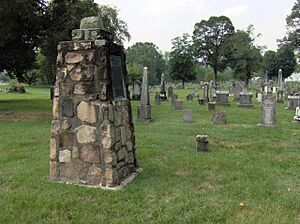Pigeon Forge, Tennessee facts for kids
Quick facts for kids
Pigeon Forge, Tennessee
|
|||
|---|---|---|---|
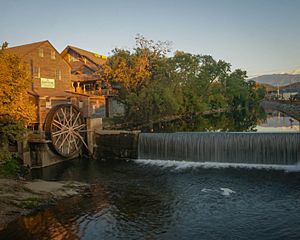
|
|||
|
|||
| Motto(s):
"The Center of Fun In The Smokies"
|
|||

Location of Pigeon Forge in Sevier County, Tennessee.
|
|||
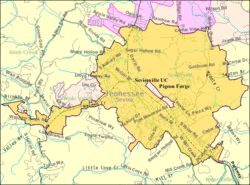
U.S. Census Map
|
|||
| Country | United States | ||
| State | Tennessee | ||
| County | Sevier | ||
| Settled | 1780s | ||
| Incorporated | 1961 | ||
| Named for | 19th-century iron forge along the Little Pigeon River | ||
| Area | |||
| • Total | 13.82 sq mi (35.80 km2) | ||
| • Land | 13.82 sq mi (35.80 km2) | ||
| • Water | 0.00 sq mi (0.00 km2) | ||
| Elevation | 994 ft (303 m) | ||
| Population
(2020)
|
|||
| • Total | 6,343 | ||
| • Density | 458.94/sq mi (177.20/km2) | ||
| Time zone | UTC-5 (Eastern (EST)) | ||
| • Summer (DST) | UTC-4 (EDT) | ||
| ZIP code |
37862, 37863, 37868
|
||
| Area code(s) | 865 | ||
| FIPS code | 47-58080 | ||
| GNIS feature ID | 2404516 | ||
| Website | http://www.cityofpigeonforge.com/ | ||
Pigeon Forge is a fun mountain city in Sevier County, Tennessee, United States. It's known as a popular place for tourists. In 2020, about 6,343 people lived there. The city is only 5 miles (8 km) north of Great Smoky Mountains National Park. Pigeon Forge is a top spot for visitors who enjoy Southern culture and country music.
Some of the city's famous attractions include Dollywood and Dollywood's Splash Country. You can also visit WonderWorks, Alcatraz East Crime Museum, and Dolly Parton's Stampede. There are many gift shops, outlet malls, rides, and music shows too.
Contents
History of Pigeon Forge
Early Beginnings
The name "Pigeon Forge" comes from an iron workshop, called a forge. Isaac Love built this forge around 1820. It was located along the Little Pigeon River, near what is now the Old Mill. The river got its name from the many passenger pigeons that used to gather there. These birds were common when the first European settlers arrived.
For hundreds of years, the Cherokee people used the valley where Pigeon Forge is now as a hunting ground. A Cherokee path, called "Indian Gap Trail," crossed the Great Smokies. It went through the Pigeon Forge valley to meet another trail in modern Sevierville. Today, US-441 follows much of this old trail.
Settlers Arrive
The Indian Gap Trail brought the first Europeans to the Pigeon Forge area in the early 1700s. Hunters, trappers, and traders traveled through the valley. After 1783, Colonel Samuel Wear became one of the first permanent white settlers. He was a hero of the American Revolutionary War. In 1792, Wear built a fort near the Little Pigeon River. This fort gave early pioneers a safe place to stop in Sevier County. Wear also helped write Tennessee's state constitution.
In 1785, the Cherokee signed a treaty, giving much of what is now Sevier County to the United States. Robert Shields, another Revolutionary War veteran, got land in Pigeon Forge in 1786. He built a small fort along Middle Creek, near where Dollywood is today. His fort was 100 feet (30 meters) long and 16 feet (5 meters) wide. Its walls were made of heavy logs. The fort had living spaces for six families.
While Shields Fort was usually safe, Wear Fort was on the Indian Gap Trail. This made it a target for Cherokee warriors. After an attack in 1793, Wear led a group of frontiersmen into Cherokee territory. They attacked a town called Tallassee. Later, in 1794, the Cherokee fired at Wear and his sons, but they were safe. Even after peace treaties, small fights sometimes happened. In 1802, a young man named Tavenor Runyan was killed by a Cherokee warrior.
The 1800s and the Old Mill
Religion was very important in early Pigeon Forge. In the early 1800s, traveling preachers, called circuit riders, came to the valley. They helped many people become Methodists. On October 20, 1808, Bishop Francis Asbury gave a sermon at what is now Shiloh Memorial Cemetery. A simple log church was built there. People also came to Pigeon Forge for long religious gatherings, called revivals, as early as 1822. These events could last for weeks.
In 1810, Mordecai Lewis, a Revolutionary War veteran, received land along the Little Pigeon River. In 1817, his son-in-law, Isaac Love, built the iron forge that gave the city its name. This forge used water power to turn ore into iron bars. Love also built the Pigeon Forge Mill in 1830. In 1841, Love's son, William, opened a post office called "Pigeon Forge." Later, John Sevier Trotter bought the mill and added a sawmill. The iron furnace was moved in the 1880s, but the Pigeon Forge Mill, often called "Old Mill," is still standing. It is now a historic site.
In the 1870s, a health resort opened in Pigeon Forge at Henderson Springs. People from cities would visit mountain springs because they believed the water was good for their health.
Growth in the 1900s
In the early 1900s, Pigeon Forge was a small, quiet mountain town. There were no major roads, and the closest train station was in Sevierville. Bridges were rare, and people crossed the river at shallow spots called fords.
When Great Smoky Mountains National Park opened in 1934, Pigeon Forge had no tourist businesses. By the 1950s, better roads led to a few campgrounds and lodges. However, two things in nearby Gatlinburg helped Pigeon Forge grow. Gatlinburg had limited land and local families controlled much of it. This meant new businesses had to look elsewhere. Pigeon Forge, just north of Gatlinburg, became the perfect spot.
In 1961, Pigeon Forge became an official city. Soon after, brothers Grover and Harry Robbins opened Rebel Railroad. This attraction pretended to be a Confederate steam train under attack during the Civil War. Later, they changed it to "Goldrush Junction" with a "Wild West" theme. It became very popular.
In 1969, Art Modell bought Goldrush Junction. In 1976, the Herschend Brothers bought it and renamed it Silver Dollar City. They gave it an Appalachian mountain theme, similar to their park in Missouri. More and more people started visiting.
In 1982, Pigeon Forge started a big plan to attract tourists. They focused on theme parks, outlet malls, and live music shows. The first outlet mall opened that year. By the early 1990s, outlet malls brought in almost half of the town's money.
With more attractions, competition grew. In 1985, the Herschends teamed up with country music star Dolly Parton. She was born nearby in Sevierville. They renamed Silver Dollar City to Dollywood, and it became a huge success.
Pigeon Forge Today
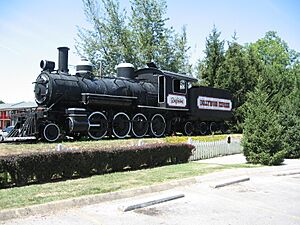
The growth in Pigeon Forge brought a lot of money to the town. However, it also made land more expensive. Some farmers could no longer afford their property taxes and had to sell their land. Also, the jobs in tourism often pay less, which can make it hard to live in Pigeon Forge.
Dollywood kept growing in the 2000s. In 2001, they added a separate water park. In 2016, the area was affected by the 2016 Great Smoky Mountains wildfires.
Historic Places
- Pigeon Forge Mill: This old mill, also known as Old Mill, was added to the National Register of Historic Places in 1975. It's a working gristmill on the Little Pigeon River. You can find it on Old Mill Drive. It includes the millhouse, a milldam, and a water wheel.
Geography and Climate
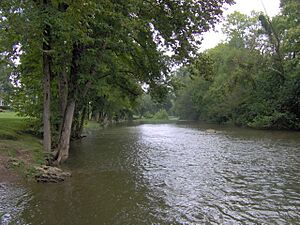
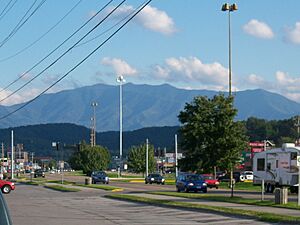
Pigeon Forge is located on the West Fork of the Little Pigeon River. The city covers about 11.6 square miles (30.0 km2) of land.
The West Fork of the Little Pigeon River flows north from Mount Collins through Sevier County. It joins another part of the river in Sevierville. Pigeon Forge sits in a narrow valley along this river, between Sevierville and Gatlinburg. High ridges surround the city on three sides: Pine Mountain to the west, Shields Mountain to the east, and Cove Mountain to the south. The river forms the city's northern border with Sevierville. A narrow gorge cut by the river marks the city's boundary with Gatlinburg.
Weather in Pigeon Forge
Pigeon Forge has a humid subtropical climate. This means it has cool winters and hot summers. It rains a lot throughout the year, especially from May to July. October is usually the driest month.
People of Pigeon Forge
Pigeon Forge is home to a diverse community. In 2020, the city had 6,343 people. There were 2,346 households and 1,712 families living there.
Population Details
In 2020, the population of Pigeon Forge was made up of:
- White (non-Hispanic): 66.92%
- Black or African American (non-Hispanic): 1.04%
- Native American: 0.27%
- Asian: 3.33%
- Pacific Islander: 0.05%
- Other/Mixed races: 3.74%
- Hispanic or Latino (of any race): 24.66%
In 2010, the city had 5,875 people. About 23.8% of the people were under 20 years old. The average age was 37.8 years. The average household had 2.58 people.
Fun Things to Do
Pigeon Forge attracts about 11 million visitors every year. People come for the beautiful nature and the many attractions. Dollywood and the Dolly Parton's Stampede theater are two of the most famous spots. Both are owned by country music superstar Dolly Parton, who grew up nearby.
Popular Attractions
- Buttonwillow Civil War Theater
- TopJump Trampoline & Extreme Arena
- Crave Golf Club
- Titanic Museum
- Cooter's Place
- Alcatraz East Crime Museum
- Southern Gospel Museum and Hall of Fame
- Country Tonite Theatre
- Paula Deen's Lumberjack Feud Supper Show & Adventure Park
- Comedy Barn Theater
- WonderWorks Children's Museum
- Smoky Mountain Opry
- Elvis & Hollywood Legends Museum
- Hatfield and McCoy Dinner Feud
- The Tomb Escape Adventure
- Dolly Parton's Stampede
- Biblical Times Dinner Theater
- Red Skelton Tribute Theater
- Flyaway Indoor Skydiving
- NASCAR Speedpark
- Smoky Mountain Alpine Coaster
- Jurassic Jungle Boat Ride
- Hollywood Wax Museum Pigeon Forge
- The Island in Pigeon Forge (with the Great Smoky Mountain Wheel)
- Tribute to Frank Sinatra & The Rat Pack
- Pigeon Forge Snow
- The Island Show Fountains
- American Oldies Theater
- Grand Majestic Dinner Theater
- Great Smoky Mountain Murder Mystery
- Ripken Experience
- Seasonal events like Winterfest
Car and Truck Shows
Pigeon Forge also hosts many events for car and truck fans. These shows happen throughout the year and include:
- Spring Rod Run
- Chevy/GMC Truck Nationals
- Great Smoky Mountain Jeep Invasion
- Shades of the Past Hot Rod Roundup
- Fall Rod Run
- Annual Patriot Festival
Parks and Outdoor Fun
The Pigeon Forge Parks and Recreation Department manages a community center and 134 acres (54 hectares) of park land. They also have about 2 miles (3.2 km) of greenways for walking.
- Pigeon Forge City Park has sports fields, courts, walking trails, and picnic areas.
- Patriot Park is 16 acres (6.5 hectares) and hosts special events. These include Independence Day fireworks and light displays during Winterfest.
- Wear Farm City Park is the main park for Pigeon Forge. It has sports fields, courts, playgrounds, and pavilions.
City Services
The city government takes care of many important services. They manage 181 miles (291 km) of water pipes and hundreds of fire hydrants. There are 20 water tanks and 19 pump stations. The city also maintains 86 miles (138 km) of streets and roads, and 89 miles (143 km) of sewer lines.
Getting Around
Pigeon Forge has a bus system called "Fun Time Trolleys." These buses look like old-fashioned trolleys. The system has over 40 vehicles and more than 200 stops in Pigeon Forge, Gatlinburg, and Sevierville. All trolleys have lifts for wheelchairs.
U.S. Route 441, also known as "The Parkway," runs through the middle of Pigeon Forge. It goes to Gatlinburg and Great Smoky Mountains National Park. Most of Pigeon Forge's tourist attractions are along this six-lane road. U.S. Route 321 (Wears Valley Road) connects the town to Wears Valley and Townsend to the west. Teaster Lane is a local four-lane road on the east side of the city, helping to bypass some of the Parkway. TN-449 is another bypass that connects directly to Dollywood.
Water and Utilities
The water plant in Pigeon Forge can clean 12 million US gallons (45 million liters) of water every day. The city's water storage system holds 8.3 million US gallons (31 million liters) of water. Pigeon Forge also provides up to 1.5 million US gallons (5.7 million liters) of water per day to Gatlinburg.
Famous People
- Dolly Parton: A famous country music singer and songwriter. Dolly Parton has many business interests in Pigeon Forge's tourism industry. She co-owns attractions like Dollywood and Dolly Parton's Stampede.
- Samuel Wear (1753–1817): A hero of the American Revolutionary War. He helped start the "Lost State of Franklin" and worked on Tennessee's state constitution. He built a fort called Wears Fort in the area that became Pigeon Forge.
See also
 In Spanish: Pigeon Forge para niños
In Spanish: Pigeon Forge para niños







